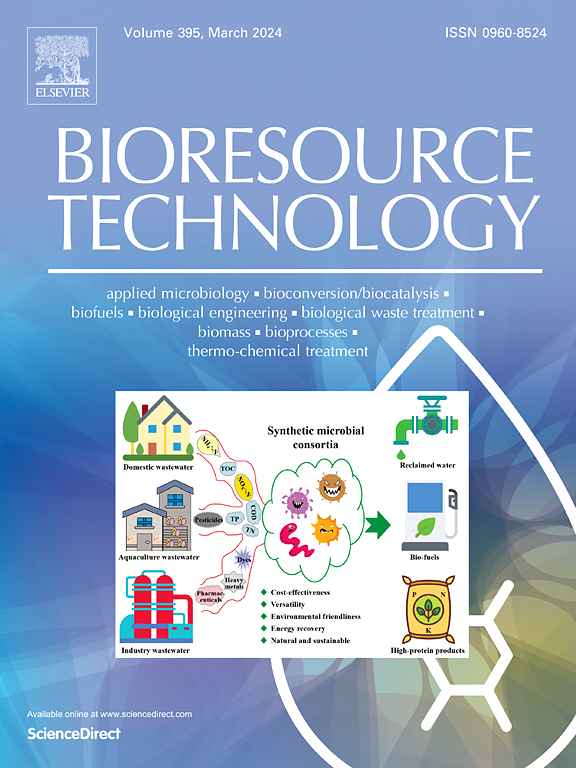SAD过程中长期高浓度有机物侵蚀引起的颗粒污泥破碎和再造粒的恢复机制:性能、污泥演化和宏基因组测序
IF 9.7
1区 环境科学与生态学
Q1 AGRICULTURAL ENGINEERING
引用次数: 0
摘要
厌氧反硝化(SAD)工艺能有效去除有机碳源,高浓度碳源对SAD工艺的影响尚不清楚。本研究研究了过量有机物暴露条件下SAD系统的性能、污泥特性、微生物群落相关性和宏基因组测序。结果表明,SAD颗粒污泥的有机物代谢能力由90.16 ± 1.16 %提高到95.2 ± 2.3 %。Mantel试验结果表明,厌氧氨氧化菌(AnAOB) (Candidatus_Kuenenia)与VSS/SS、不稳定系数呈显著正相关,反硝化菌(DNB) (Truepera、Ottowia、Deniratisoma、Arenimonas)与湿密度、沉降速度、粒径、蛋白/多糖(PN/PS)比、完全系数呈显著负相关。随着SAD系统的恢复,细菌群落相关性增加,颗粒污泥的稳定性和机械强度增强。宏基因组测序结果显示,群体感应(Quorum sensing, QS)的降低和c-di-GMP水平的升高导致胞外多糖和胞外蛋白表达上调,导致SAD颗粒污泥解体。随着污泥聚集、重组、再造粒,系统通过c-di-GMP和QS信号上调AnAOB氮代谢中hzs基因的表达。上调硝酸异同化还原成铵(Dissimilatory Nitrate Reduction to铵,DNRA)和潜在反硝化途径等基因的表达,促进AnAOB和共生细菌的代谢。本文章由计算机程序翻译,如有差异,请以英文原文为准。

The recovery mechanism of granular sludge fragmentation and re-granulation caused by long-term high-concentration organic matter erosion in the SAD process: performance, sludge evolution, and metagenomic sequencing
The Simultaneous Anammox and Denitrification (SAD) process effectively removes organic carbon sources, the impact of high-concentration carbon sources on the SAD process remains unclear. This study investigated the performance, sludge characteristics, microbial community correlations, and metagenomic sequencing of the SAD system under conditions of excessive organic matter exposure. The results showed that the organic matter metabolism ability of SAD granular sludge increased from 90.16 ± 1.16 % to 95.2 ± 2.3 %. The Mantel test revealed that Anaerobic Ammonium Oxidation Bacteria (AnAOB) (Candidatus_Kuenenia) were positively correlated with VSS/SS and instability coefficient, while Denitrifying Bacteria (DNB) (Truepera, Ottowia, Deniratisoma, Arenimonas) were negatively correlated with wet density, settling velocity, granule size, protein/polysaccharides (PN/PS) ratio, and the complete coefficient. Following the recovery of the SAD system, the bacterial community correlations increased, and the stability and mechanical strength of the granular sludge were enhanced. Metagenomic sequencing showed that a decrease of Quorum sensing (QS) and the increase of c-di-GMP levels led to up-regulation of exopolysaccharide and extracellular protein expression, resulting in the disintegration of SAD granular sludge. As the sludge aggregated, recombined, and re-granulated, the system up-regulated the expression of the hzs gene in AnAOB nitrogen metabolism via c-di-GMP and QS signals. It also up-regulated the expression of genes such as Dissimilatory Nitrate Reduction to Ammonium (DNRA) and potential denitrification pathways, enhancing the metabolism of AnAOB and symbiotic bacteria.
求助全文
通过发布文献求助,成功后即可免费获取论文全文。
去求助
来源期刊

Bioresource Technology
工程技术-能源与燃料
CiteScore
20.80
自引率
19.30%
发文量
2013
审稿时长
12 days
期刊介绍:
Bioresource Technology publishes original articles, review articles, case studies, and short communications covering the fundamentals, applications, and management of bioresource technology. The journal seeks to advance and disseminate knowledge across various areas related to biomass, biological waste treatment, bioenergy, biotransformations, bioresource systems analysis, and associated conversion or production technologies.
Topics include:
• Biofuels: liquid and gaseous biofuels production, modeling and economics
• Bioprocesses and bioproducts: biocatalysis and fermentations
• Biomass and feedstocks utilization: bioconversion of agro-industrial residues
• Environmental protection: biological waste treatment
• Thermochemical conversion of biomass: combustion, pyrolysis, gasification, catalysis.
 求助内容:
求助内容: 应助结果提醒方式:
应助结果提醒方式:


